
“Dude! I have to tell you about the Rivian R1T. It’s unbelievable!” I exclaimed over the phone to my coworker Jason Torchinsky. I had just spent the day off-roading the very first vehicle from American electric car startup, Rivian, near Breckenridge, Colorado and came away both astonished and fascinated by the four-motor 4x4 system’s performance. In my 6.5 years as a car journalist, I’ve never felt this excited about a new automobile.
Allow me to begin by saying that I didn’t enter this test drive as an EV fanboy. I recognize electric vehicles’ environmental advantages, I appreciate and voraciously study their engineering attributes, and I love the benefits they offer in terms of driveability and durability. But I’m an enthusiast first. My focus is on fun, regardless of powertrain technology.
I should also mention that I own three pickup trucks — all manual transmission, four-wheel drive, old-school machines. And I’ve been reviewing new pickup trucks — from Ford, GM, Ram, Toyota, and Honda — for years now, so I have a solid grasp of what it takes to be competitive in this class.
With that context established, I’ll just say it: The Rivian R1T may not be the workhorse of the truck world, but it’s still an absolute masterpiece.
(Full Disclosure: Rivian shuttled me from the Denver Airport to Breckenridge, then housed me in a lodge and fed me good food. The company’s head of special projects even took me out on a three-mile run, though he did not take it easy — he destroyed me. It was clear that he was the quad-motor EV, and I was the wheezy naturally-aspirated ICE.)

Up until now, my biggest concern about EVs has been whether they can actually satisfy enthusiasts’ desires. I’ve driven the Tesla Model S, Tesla Model 3, Porsche Taycan, and several other sporty EVs. They’re great machines in so many ways, but none of them really moved me in a way the best ICE sports cars do.
The Ford Mustang Shelby GT350 is an example I often cite. I still vividly remember driving one on Angeles Crest highway in California back in 2019. I reminisce about the engaging six-speed manual transmission — the way it thunked into gear, and the way the shifts dramatically changed the car’s acceleration. I think about the coupe’s relatively low curb weight and excellent handling. I remember that amazing V8 engine whose sound constructively interfered with the melody of my soul. I recall that unique torque curve that rewarded spinning the crankshaft up to ridiculous speeds.
Sure, the GT350 is slower than the Porsche Taycan in a straight line, but even the Taycan — arguably the most exciting mass-market EV out right now — didn’t make me feel like the GT350 did. It really wasn’t even close.
I’m not the only one who thinks this way. My boss Rory Carroll recently published an excellent review of the Cadillac CT5-V, a supercharged V8 sports sedan roughly in the same size-class as the Tesla Model S and Porsche Taycan. In many ways, Rory painted the Cadillac — which he gave an A+ grade — as a swan song to the viscerally stimulating ICE sports sedans that have arguably reached their pinnacle just before their departure. From Rory:
But as the internal combustion era draws to a close, I’m trying hard to etch the kinds of singularly joyful driving experiences that these cars are so good at providing into my brain. And I’m about as sure as I get that while EVs may end up being fun in their own way, once these Blackwing cars are gone, the particular sensations they’re made to elicit will go with them.
I mention all of this because I had similar questions about pickup trucks. Would electrified powertrains compromise what I, a diehard truck enthusiast, want in a pickup? After driving the Rivian R1T both on and off-road, I’ve concluded that the answer is a definitive no.

A pickup truck enthusiast doesn’t usually look for the same things that a sports car enthusiast seeks. It’s not about manual transmissions and amazing-sounding engines. (Well, not anymore now that most modern pickups are equipped with not-particularly-sporty-sounding four-cylinder or six-cylinder engines bolted to automatic transmissions). For truck enthusiasts, it’s more about style, practicality, and off-road capability.
And though things like brand loyalty play big roles in the pickup market, as do antiquated views of what powertrain a truck should have (we all still remember the hoopla that resulted when Chevy announced a four-cylinder for the Silverado), I know that if people give the R1T a chance, they’ll see it’s an amazing enthusiast’s pickup truck. That is, unless towing/hauling long distances is a big deal to them. But more on that later.
If I had an unlimited budget and could buy any pickup truck today, it’d be an R1T. It’s that good.
What Is It?
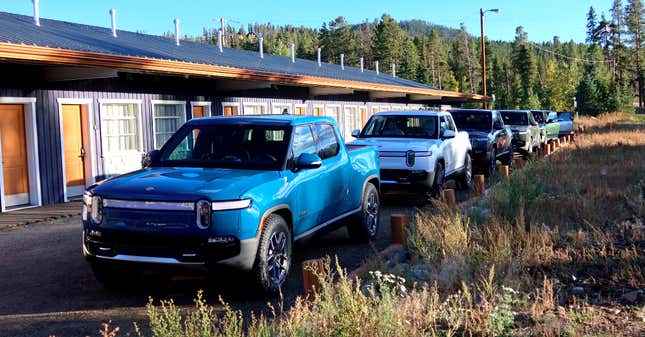
The R1T is the first vehicle from American electric vehicle startup Rivian, which is headquartered in Irvine, California, and which owns engineering operations in Plymouth, Michigan and a former Mitsubishi manufacturing plant in Normal, Illinois. It’s a small but rapidly-growing company founded by MIT Sloan Automotive Lab alum RJ Scaringe and now financed by the likes of Amazon, Ford, and T. Rowe Price.
Rivian has been around in some form for over a decade, although it was only in 2018 at the Los Angeles Auto Show, where it revealed the R1S all-electric SUV and R1T all-electric pickup truck, that the company entered the spotlight. Rivian wowed the automotive world not just with its claimed range (over 300 miles) and horsepower figures (over 800) but also with the vehicles’ styling, packaging solutions, and whiz-bang gadgets.

The backbone of the Rivian R1T is a skateboard chassis, not unlike those used in many new electric vehicles. Between the two axles, inboard of the vehicle’s main structural rails, sits a 135 kWh battery pack composed of 7776 cylindrical lithium-ion cells.

The drivetrain and powertrain are fascinating. Most modern all-wheel drive EVs have a motor on each axle driving a differential that sends power left and right, while also reducing motor output speed by a factor of around 10. Rivian, however, eschews differentials entirely, instead choosing to have a separate motor drive each individual wheel through a longitudinally-oriented gear reduction. The whole dual motor/dual gearbox arrangement for each axle is part of a single housing, with inverters and power electronics cleanly mounted in a case on top.
Rivian’s drivetrain engineer told me that part of the reasoning behind the setup is that it ensures that the gearbox output is as far inboard as possible. This allows for relatively long axle shafts, which means the axles’ constant-velocity joints won’t be at too steep of an angle when the suspension is at full droop. For an off-road vehicle, CV joint angle is often a major limiting factor when it comes to suspension travel, which you want to maximize to keep tires on the ground at all times.

Speaking of suspension, the R1T has a fully independent design with air springs that vary ride height from around eight inches to more than 14 inches. The suspension includes adaptive damping that stiffens up when in sport mode and softens for improved comfort.

Looking underneath, you won’t see any sway bars. Instead, Rivian uses “electro-hydraulic roll control.” I need to talk more with Rivian engineers to better understand the system, but my current understanding is this: Fluid in the dampers on the left and ride side of the vehicle is connected via piping, which contains a valve/orifice that limits flow. The restriction of that valve/orifice dictates the amount of roll, with zero flow essentially limiting body roll to close to zero (due to the incompressibility of the oil).
One of Rivian’s dynamics engineer told me that his team used the Porsche Cayenne as a handling benchmark, aiming for three degrees of roll per g of lateral acceleration.
An Off-Road Beast

Speaking of benchmarks, a company rep told me Rivian used the Land Rover Discovery as the standard for off-road comfort. They also assessed the Ford Raptor and Jeep Wrangler Rubicon’s off-road attributes. The studying paid off, because after driving the Rivian R1T, I’m convinced that it could very well be the most capable off-road pickup on the market.
This is a huge statement from a solid-axle diehard like myself, but I’ve said it once and I’ll repeat it: The single most important attribute of any off-road vehicle is favorable geometry. That means short overhangs, high ground clearance, and a small (but not too small) wheelbase.
Sure, the Jeep Gladiator Rubicon — the current off-road truck champ (maybe tied with the Chevy Colorado ZR2) — has solid axles. And it almost certainly scores a higher Ramp Travel Index score (an indicator of how well a vehicle’s suspension keeps the tires on uneven terrain) than the Rivian. The Jeep also has locking differentials, great gearing, and a much lower curb weight. But in the off-road hierarchy, there’s favorable geometry at the top, then a huge gap, then the rest. And the Rivian’s geometry is king.
Phenomenal Geometry

With the air suspension raised in off-road mode, ground clearance is nearly 15 inches — far higher than that of any other new pickup today, including the Gladiator Mojave. That gives the Rivian R1T an approach angle of 34 degrees, which is a good figure but not top of the class.
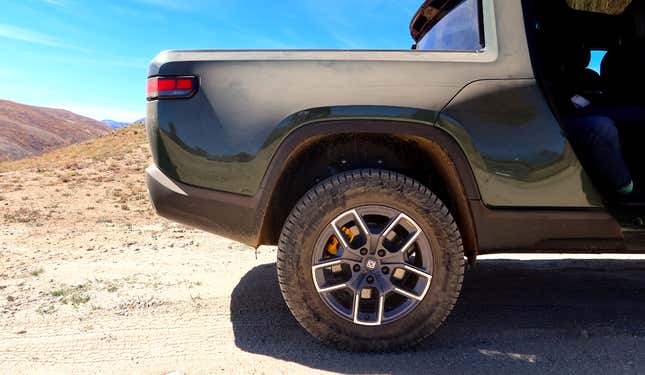
That’s okay, though, because a high approach angle with tiny breakover and departure angles doesn’t really offer that much value. Sure, it gets the nose up and onto steep obstacles, but that’s often not helpful if the belly high-centers or the rear bumper drags. I’ll admit that approach angle is the most important of the three, since you can use velocity to drag the belly, and you can carefully drag the rear hitch if you must. But the reality is that, in the off-road world, it’s helpful to have a balanced set of off-road angles so that there’s not one weak link holding the vehicle back.

The video below is a great demonstration of my point. The Gladiator’s class-leading 43.4 degree approach angle and its solid 11.1 inches of ground clearance are severely hampered by a 20.3 degree breakover angle and 26 degree departure angle. Watch as the belly and tail drag all over the rocks on the Rubicon Trail:
The Rivian’s off-road geometry is nicely balanced thanks to its excellent breakover and departure angles, two numbers that are hard to keep down on a pickup truck due to the length requirements associated with packaging four-doors plus a pickup bed. The R1T’s clever packaging, its air suspension, and its stock 34-inch all-terrain tires (the largest in the segment) enable a breakover angle of 25.7 degrees and a departure angle of 29.3 degrees. (The R1T’s bed is around 54 inches, or about six inches shorter than most in the segment, which also help).
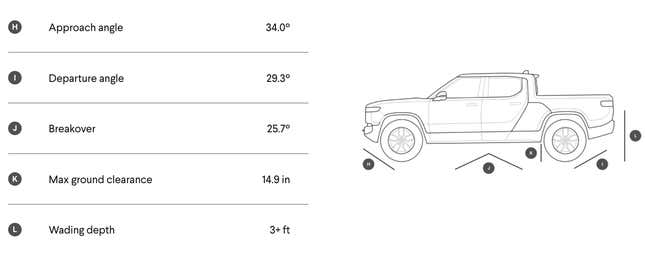
These numbers are unheard of in the truck world, where huge rear overhangs and low bellies abound. The two most off-road capable pickups on the market today, the Jeep Gladiator and Chevy Colorado ZR2 have breakover angles of 20.3 and 23.5, respectively. As for departure angles, those two trucks measure 26 degrees and 23.5 degrees, respectively. The only truck I can remember with a departure angle as good as the Rivian’s is the now-extinct Hummer H3T, but it traded a 30.6-degree departure angle for a pathetic 20.2 degree breakover angle.

The Rivian is strongest in the most important off-road category, and it showed in the Colorado rockies where I drove a yellow R1T on the company’s off-road course not far from Breckenridge. It was a scenic trail offering plenty of jagged terrain, steep grades, and slippery surfaces. The Rivian’s 275mm-section Pirelli Scorpion all-terrains stomped all over the boulders, lifting the vehicle up and away from danger, keeping bumpers, rocker panels, and underbody components safe from damage.
With the R1T’s impressive ground clearance, I also marveled as the truck straddled enormous rocks that, in most other off-road vehicles, I’d have to place a wheel onto in order to prevent underbody damage.

The Rivian R1T’s geometry meant I could point the truck wherever I wanted to go and just watch in awe as the vehicle handled its business without too much drama.
Traction And Gearing — The Four-Motor System Isn’t Perfect
I say “without too much drama,” because off-roading the Rivian isn’t entirely drama-free.
Going into this press trip, I was interested to see how well a four-motor system would handle off-road duty. With one motor per wheel, you might think the R1T’s four-wheel drive system would outshine that of any other off-road vehicle due to the four motors’ ability to apportion power more precisely than clutches, brakes and other mechanical connections used in more traditional setups. But that’s really not how things played out.
While shooting the video above of the R1T traversing Colorado’s bumpy trails, I noticed that, although the truck performed well, there was more wheel-spin than you might want while off-roading. To be clear, there are certain scenarios where wheel-spin (technically defined as when the magnitude of the tangential velocity of the tire at the contact patch exceeds the magnitude of the linear velocity of the vehicle relative to the ground) is a good thing.
For example, when mudding, spinning up the tires shoots grime out from a tire’s grooves, cleaning them and allowing them to scoop up more mud to propel the vehicle forward. Rock crawling, like what you see in the video, is not an instance where significant wheel-spin is advantageous.
This becomes apparent in the beginning of the video above, where you can see wheel-spin making it more difficult for the driver to precisely navigate the trail (notice how the nose of the truck yaws a bit as a tire loses traction and slides off slippery rocks). Later in the clip above, during the segment where the blue truck climbs a steep rocky trail, you’ll notice the wheels spin up and kick dirt and rocks. That doesn’t really help the truck climb the grade, and it tears up the terrain.
Would a vehicle with a single motor and old-school front and rear locking differentials perform better in these conditions? Possibly. Let’s discuss a scenario where a vehicle is climbing a steep, slippery grade.
To climb that grade at a given velocity (we’ll call it 2 MPH), the vehicle requires a certain amount of torque at the wheels. Imagine you’re driving a Jeep Wrangler Rubicon up this grade, and your foot is pressing the accelerator pedal a given amount, causing you to cruise up the grade at a constant velocity.
Now let’s say the passenger’s-side front wheel hits an ice patch and loses all grip, but the driver maintains the same pedal position. Will the tire slip (i.e. will its tangential speed exceed the vehicle speed)? The answer is: only if the three other tires — with which the tractionless tire is mechanically linked — cannot make up for the lost traction.
In other words, if the three tires with grip have enough traction such that the torque at the three wheels equals the required total wheel torque to ascend the grade, the vehicle will keep moving at a steady rate, and the tractionless tire’s tangential velocity at the tread will likely equal close to the vehicle’s velocity. The ascent will be smooth.

Put more simply, let’s just model the Jeep Wrangler Rubicon’s driveline as one big axle with four tires on it. Torque is being sent through that big axle, and all four tires are spinning at the same rate because they share a common shaft. If one or two or three tires roll over ice, the giant axle will continue moving steadily so long as the friction coefficient between the ground and the tire(s) with grip is capable of producing enough torque against the tire to meet or exceed the wheel torque needed to ascend the grade. (Note: There will be a yaw moment depending upon which tires have grip).
With Rivian’s system, what happens? Well, let’s again say you’re climbing that same hill with the pedal depressed a certain amount. A given amount of current is being sent to the wheels, producing the requisite wheel torque to ascend the grade at 2 MPH.
Now let’s say the passenger’s side tire loses all grip; what happens? Well, the wheel torque there goes to zero, and the wheel slips until the vehicle can pull current from that motor; does the wheel torque at the other three wheels instantly increase like it does with a fully-locked ICE in order to maintain a steady vehicle speed? Not instantly. The vehicle’s electronics have to quickly send more current to the other motors with grip to keep the vehicle moving at a given rate.
How much current do you send each wheel? What if you send too much current to a wheel that doesn’t have quite enough grip, causing wheel-spin? As for the wheel without grip; should it keep spinning at a rate that corresponds with vehicle speed so that it doesn’t have to accelerate once it does get grip? If so, how do you know what the vehicle speed is?
It’s really complicated. I spoke briefly with Principle Engineer of Rivian’s Drive System team Mason Verbridge, and though I definitely need to chat with him more to fully understand the complexity of a four-motor four-wheel drive system, here’s what he told me.

“I wanna say our [refresh rate] is 100hz in the inverter” he said. “Basically our torque command can change let’s say on the order of 100hz. 100 times per second you can say ‘Am I going too fast, too slow.’”
Verbridge said the R1T’s four-wheel drive system isn’t meant to simulate a locker. “But basically where you set your slip target defines how close to [a locker] you are. Slip targets are surface dependent — what the vehicle expects the mu [friction coefficient] to be will change how much we allow the wheel to slip above whatever we think is vehicle reference speed.”
“That does get tricky... if all four wheels are spinning, what is vehicle reference? GPS can help you a little bit, but you don’t know how fast is the ground moving beneath me, right?” he continued. “But in the case of one wheel we generally have a good idea from the other three how fast is the vehicle actually going, and we can keep that slip within check.”
Think about that for a second. Rivian’s system has to not only predict the friction coefficient (which is constantly changing!) but it also has to figure out what the vehicle’s speed is, which isn’t easy to do if there’s slip at all corners.
Verbridge admits there are limitations to the system. “There’s a PID gain loop there... a control reaction time iteration time in your way,” he said. “To your point, it’s not gonna be perfect. How quickly can you go ‘I’m slipping. Stop.’ That’s your limit of the technology.” He notes that the system is quick, but admits that the wheels do flare up a “quarter turn at a time” before the control software brings the wheel speed down.

He also mentioned that Rivian is looking at fewer-motor setups for future products. He emphasized that this four-motor system offers real benefits in high-speed off-road conditions, and he made it clear that the novelty of a four-motor setup is key to helping the R1T stand out from the pack.
Rivian launching with the kitchen sink, he implied, is the way to make a splash. And I agree with him, even if I think a two-motor setup might actually be a better overall design for the layperson. Not just from a cost perspective, either, but also from a weight and packaging perspective. Plus, it could actually be better off-road in a narrow set of scenarios, and I bet not too much worse in high-speed ones.
“Everything’s a tradeoff,” Verbridge told me about the four-motor system’s overall performance on and off-road. “We’re kind of evaluating that for ourselves. How much of this can we replicate with two or three or one? Where are the real objectionable limits?”
I also spoke with an engineering source outside of Rivian just to talk through what I experienced with the four-motor EV off-road. Here’s what they told me:
Fundamentally, you’re absolutely correct - if your only focus is to maximise traction, 3 locked diffs will always win for the reasons your 4 tyres on 1 axle analogy explains neatly. No control system will ever be quick enough to truly mimic the effect of anchoring all the wheels to each other so that a wheel can only spin once you’ve exhausted the traction available from the sum of all 4 tyres. Another significant factor there is that spinning the wheel on some surfaces, like compacted wet mud or wet grass, can polish the surface, further reduce the friction coefficient and exacerbate your traction problems.
However, the “IF” in “if your only focus is to maximise traction” is a huge if, as anyone who’s decided to drive their old-school 4x4 on-road with the diffs locked to see what it’s like can relate to!
Having individual wheel control, through multi-motor electric drive units opens up a world of torque vectoring possibilities to increase agility and disguise the mass of a heavy BEV truck on-road, but for the off-road conditions where you’d traditionally lock the diffs, there will always be some level of trade-off. The system will only ever be as good as the mu estimation and tyre vertical load estimation model, and how it correlates that to torque requests for each wheel.
All of this is before you get onto the subject of safety cases for individual wheel motors and all the additional work that drives - who fancies being the first person to test the car in the scenario where the left side motors go to full positive torque, and the right side goes to full negative torque? But that’s probably another article in itself...
The Articulation Is Okay

The Rivian R1T’s air suspension allows for lots of ride height adjustment, which has benefits for both on-road driving dynamics and off-road capability. This is enabled, in part, by Rivian’s decision to locate the drive unit outputs far inboard, which keeps CV angles at a minimum.
“Articulation is everything, CV joints hate angle...Literally everything we could think of to move that inboard CV joint more inboard, we did,” Verbridge told me.
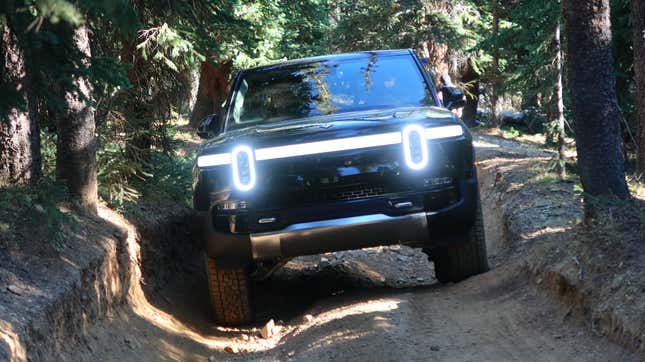
At a given ride height, the suspension flexes well enough to keep tires on the ground most of the time, though this isn’t a long-arm suspension setup, and it’s certainly not a solid axle design. As you can see in the video I showed before of the R1T in Moab, overall suspension articulation is modest when compared to solid-axle off-roaders.
If I had to guess based solely on an eye-test, I’d say the R1T’s Ramp Travel Index score is likely just a bit lower than that of mid-size trucks with independent front suspensions and solid rear axles — that’s most mid-size trucks, including the Toyota Tacoma TRD Pro, Chevrolet Colorado ZR2, and Ford Ranger FX4.
As is typical with vehicles equipped with air suspension, off-road ride quality at maximum ride height wasn’t great, with the suspension topping out when rebounding from bumps. This occasionally manifested itself in clunky sounds and a somewhat jerky ride, although in lower ride-height settings it wasn’t an issue.
Pedal Calibration Was A Bit Tricky

One area where I had some trouble was with maintaining speed over obstacles. The relationship between the R1T’s accelerator pedal position and the wheel torque propelling the truck over obstacles wasn’t intuitive given the lack of sound and the nature of electric vehicles’ torque curves/drivetrain designs.
When you reach an obstacle in a vehicle powered by an internal combustion engine, you press the accelerator pedal gradually, and you can sense the torque building up in the driveline. The engine gets louder and vibrates the cabin as the torque converter’s turbine inches toward a nonzero angular velocity that propels the vehicle forward. You can feel and hear how your pedal position affects driveline torque, so it’s easy to understand and anticipate the boundary between being stationary and moving.

In the R1T, sensing how the pedal’s position would affect the vehicle’s forward motion wasn’t as intuitive. Pedal calibration changes based on the drive mode you’re in, changing how much current is sent to the motors for a given pedal position. (Obviously, there are other factors besides pedal position that play a role, such as the predicted friction coefficient mentioned earlier). Even in Rivian’s rock-crawl mode, which desensitizes the pedal, I could never quite predict how much pedal I needed to slowly ascend a given obstacle.
I’d reach a big rock, press the pedal more and more, and eventually the truck would begin climbing, but without much warning. Perhaps some sort of sensory feedback like an audio signal would be helpful in such a scenario. Though I will say that the truck’s quiet operation in the middle of the Colorado wilderness was truly magical. I’ll also say that, in time, it’s possible that I’d have gotten used to the pedal calibration.
With that said, I think Rivian should offer an off-road cruise control function like Toyota’s Crawl Control or Ford’s Trail Control. Allow the driver to set the speed to 1 mph or 2 mph (based on how slowly I was able to get the Rivian to steadily move, I bet the company could offer much smaller speed increments than what’s currently on the market), take their feet completely off the pedals, and let the vehicle figure how to navigate the terrain. It would require nothing but software, and I wouldn’t be surprised if Rivian is already at work on this.
Underbody Protection Is Decent

The final subcategory of off-road performance that I’d like to discuss is underbody protection. In other words, how well will the Rivian R1T hold up to off-road abuse?
I obviously can’t answer that until I’ve put some serious off-road miles on the truck, but looking at the underbody design, I’m certain the R1T can take a beating.

Pretty much the entire underbody is flat, protected by a thin-but-strong sheet of carbon fiber. This should create a puncture-resistant layer that protects the battery and drive-units. Plus, the surface allows the truck to slide easily over obstacles should it high-center.
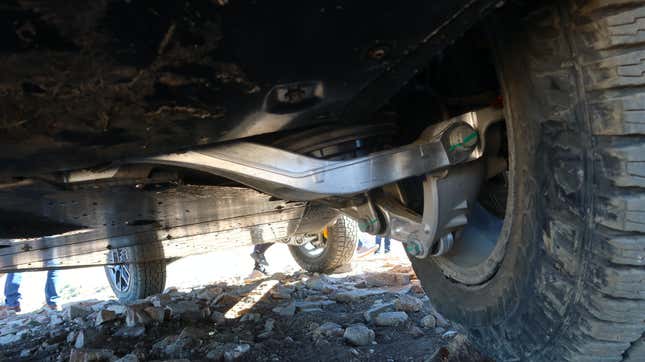
As you can see in the images above, the suspension parts are all far outboard, close to the tires. This is what you want, as it pretty much guarantees protection since the tire will likely crawl up and onto any obstacle that threatens to hit one of the arms. Axle shafts and CV joints appear well-protected, and though there aren’t rock-sliders along the vehicle’s rocker panels, all the plastic cladding on the lower doors and bottom bits of the bumpers/bedsides should help keep the body from sustaining dings/scratches off-road.
It’s Good On-Road, Too

Oftentimes during a press drive, automakers will have journalists drive a lower trim level on the street and save the off-road trim (the one with taller suspension and bigger tires) for the trail. The idea, of course, is to present vehicles in environments where they perform best. But Rivian didn’t do that. And honestly, it didn’t have to, because for a pickup truck, the R1T is great both off and on-road.
On the street, even the R1T with all-terrain tires was quiet and comfortable. Punch the pedal, and the four motors whir, shooting the vehicle from zero to 60 mph in three seconds according to Rivian. And I believe it. This truck may weigh close to 7,000 pounds, but 800 horsepower has a way of masking that.
I drove the yellow Rivian through mountain roads, and found the handling and steering to be solid. There wasn’t much body roll, the steering was tight and responsive, and the ride remained nice and compliant.
I was going slowly, though, since I’m not particularly adept at track-style driving. My co-pilot, however, took a different approach; when he grabbed hold of the reins, he threw the truck into turns at speeds that made me thoroughly uncomfortable to the point where I nearly told the guy to relax. We’re reviewing a car, not a life insurance policy.
In his defense, though, things always seem faster from the passenger’s seat, where I felt the truck grip far harder than I’d expected. I don’t know how much the truck was taking advantage of its precise torque-vectoring abilities to steer us through those turns, but the lateral acceleration was seriously impressive.
For a vehicle to be that good off-road, and to also demonstrate impressive ride and handling attributes on road — well, that’s the beauty of air suspension, a body design that promotes a low center of gravity, precise torque vectoring capability, and just some fine engineering.
Awesome Gadgetry/Tech, But Not Without Flaws
Part of what makes the Rivian R1T so compelling is its emotional appeal. Step into the cabin, and you’re greeted with the most beautiful wood dash you’ve ever seen in a pickup truck. The seats are equally pretty, the floor-mats are stylish, and the gadgets and gizmos abound, drawing you in and tickling the child-like parts of your soul.
I’ve already written about all of the Rivian R1T’s whiz-bang features, so read that article and watch the clip above to get a better idea of all the surprising gadgetry that contributes to the R1T being such a fun truck.



Of course, it wasn’t all perfect. Not having a handle to grab made getting into the truck — particularly when its ride height was jacked up in off-road mode — a huge chore, even for a spry, young-ish 30 year-old like me.

While we’re on the topic of quibbles, the infotainment system was filled with bugs — features that simply didn’t function like they were supposed to. Rivian did say it’s working to fix it, so hopefully that won’t be an issue in the production version. Speaking of that infotainment system, the screen showed a front view camera image that is unacceptably grainy and felt totally out of place in such a tech-focused machine.

I’ll also mention that grabbing the interior door latch release handle required me to move my leg inboard, which I found to be a minor annoyance:

Additionally, I’d give the truck’s lane-keeping system a D- grade, as the R1T that I was driving back to the airport drifted right into adjacent lanes, forcing me to intervene. I also found the center armrest’s electronic latch to be a bit silly — ditto with the bluetooth speaker latch. These things should be mechanical, as there’s no need to introduce the cost and potential failure modes, even if I will admit that I found the tech charming at first.

Another gadget that wasn’t perfect was the Gear Tunnel. More specifically, the seams on the doors looked a bit sloppy.

Speaking of closures, the tailgate’s switch being on the driver’s side of the bed is a bit odd. This seems like something that should be centered on the gate.

Once you open that gooseneck tailgate (designed to add length in case you want to carry something that extends out of the bed), a plastic spacer rolls down the inside of the tailgate and fills the gap between it and the bed floor.
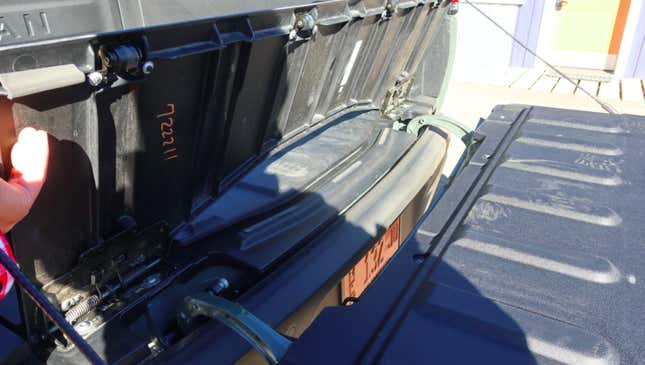
But as I mentioned in my other article, when closing the tailgate, that spacer sometimes got jammed up against the closed under-bed storage lid, which was sitting proud due to a poorly-functioning passenger’s-side latch.

Though imperfect, the Rivian’s beautiful interior and its fun whiz-bang features actually impressed me more than even the off-road or on-road performance did. The cabin is just a cool place to hang out, and the novelty features are a delight.
Verdict

The Rivian R1T is imperfect. Its software has bugs, there are some mild build quality issues on the preproduction trucks that I drove, the front-facing camera is grainy, the four-wheel drive system kicks up rocks when you don’t want it to, pedal modulation can be tough to get used to off-road, articulation isn’t amazing, and the truck costs a lot (the ones I drove were over $70 grand) and weighs a lot (roughly 7,000 pounds).
Plus, as a utility vehicle, it’s not great. The bed is tiny, and though the tow rating is 11,000 pounds, yanking that heavy of a load — especially in a box trailer uphill — will likely lead to double-digit range figures; the same applies to hauling lots of weight in the bed. Though Rivian says its fast chargers can bring the truck’s battery from zero to 140 miles of range in just 20 minutes, such a short range would be annoying given the U.S.’s poor-but-growing charging infrastructure.
Despite all of this, the Rivian R1T is a masterpiece and a true enthusiast’s machine for people who like to daily-drive their trucks and who aren’t in it for long-range heavy towing/hauling. It’s exceptional off-road and great on road, it looks awesome, its interior is stunning, its useful and sometimes superfluous gadgets are incredibly charming, and acceleration is absurd.
There’s a reason why immediately upon returning from a day driving the R1T, I had to call Jason: The Rivian moved me like no new vehicle ever has. It’s that cool.
